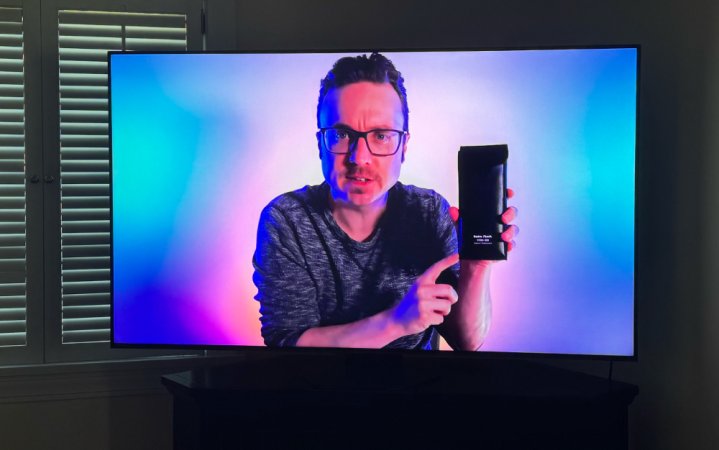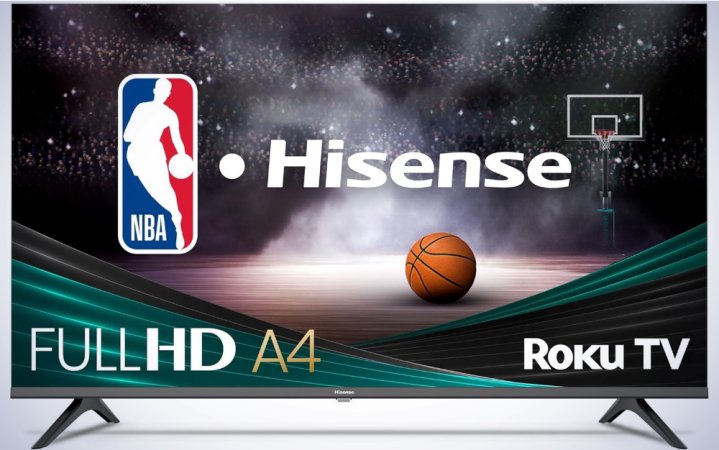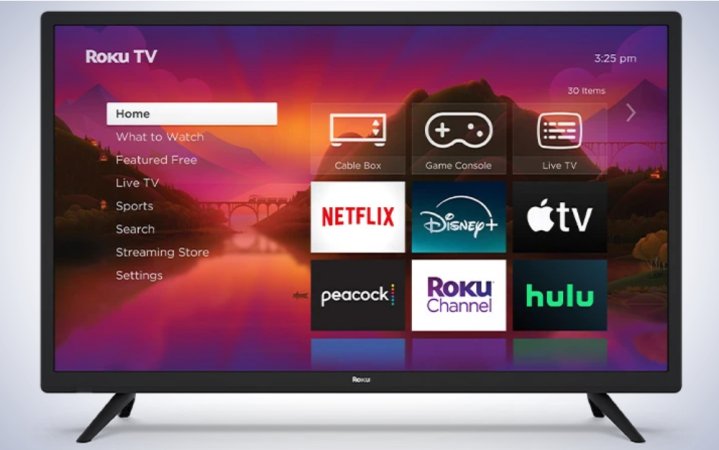Televisions have gotten a lot larger, sharper, and smarter, but these changes have all made them more difficult to use if you’re not tech-savvy. Access to every streaming channel baked in doesn’t matter if all you’d like to do is watch live TV from a cable box or broadcast channels using an HDTV antenna. The good news is that there are many great smart TVs for seniors—even if you completely ignore all the smart features. When a smart TV is configured as simply as possible—maybe not even connected to the internet—it will continue to work in perpetuity. All smart TVs come with a remote, but you can sync one of them—like our best overall, the Roku Select Series 4K Smart TV—to a third-party model with larger buttons if necessary. The best smart TVs for seniors will be as simple to use as a traditional TV but will look and sound a lot better.
- Best overall: Roku Select Series 4K Smart TV
- Best splurge: Hisense 65U8N
- Best 55-inch TV: TCL QM7 QLED 4K Smart TV
- Best HD: Hisense A4 Series 1080p Smart Roku TV
- Best budget: Roku Select Series 1080P Smart TV
How we chose the best smart TVs for seniors
Our recommendations for the best TVs for seniors are based on both hands-on testing and research. The factors we considered most heavily when making our decisions were the size of the TV, its ease of use, and its resolution. These TVs must work reliably whether their smart features are used frequently or not, and should be compatible with a universal remote that seniors may feel more comfortable using. We’re talking as simple as a Fitbit—a one-button wonder that requires very little interaction in order to deliver the desired experience. Finally, these TVs should work similarly to the sets that seniors have used before to avoid their having to learn an entirely new system to watch the TV shows and movies they’d like.
The best smart TVs for seniors: Reviews & Recommendations
Below are five TVs that seniors can feel comfortable picking up and using easily. Whether they stick to basic cable or count down the days until a new season of their favorite series drops on Netflix or HBO Max. Many of them cost $500—one as low as $150—so they’re accessible to anyone on a fixed income or otherwise tight budget for technology. Notably, these lower prices do not mean missing out on important features like easy access to streaming services or subpar panels.
Best overall: Roku Select Series 4K Smart TV
Specs
- Size: 65-Inch
- Resolution: 4K
- Operating system: Roku OS
- Price: $399.99
Pros
- Large size
- High-resolution panel
- Roku OS is easy to use
Cons
- Price
Roku’s Select Series TV offers a massive screen, an easy-to-use interface, and a shockingly affordable price. The 65-inch TV is 4K, so videos and text will look sharp, plus support for HDR10+ (High Dynamic Range) means colors will look more lifelike. The version of the Roku remote with the Select TV features four dedicated buttons for Netflix, Disney+, Apple TV+, and HBO Max to access those services immediately. Buttons labeled 1 and 2 let users jump to other services or inputs with a single push. This is helpful if you’d like to quickly access additional streaming services, including Peacock or Paramount Plus.
These buttons can also be mapped to different inputs, making it easy to access a cable box or DVD player at the push of a button. Another handy feature of the Roku remote is a 3.5mm audio jack, which automatically routes audio from your TV when you connect a standard pair of headphones. If you’re hard of hearing, this feature can be transformative. If you find jumping from app to app frustrating or confusing, you can press the microphone button on the Roku remote and search for movies, TV shows, or other content using your voice.
Seniors who have recently cut the cord will appreciate the Roku TV app, accessible from the TV’s home screen. This application lets you stream dozens of digital TV channels 24/7, including some live programming. All of these premium features are available on a TV that’s pretty affordable but still on the expensive side of the spectrum. Still, you get what you pay for, and any senior looking for a large, easy-to-use TV doesn’t need to look any further.
Best splurge: Hisense 65U8N
Specs
- Size: 65-Inches
- Resolution: 4K
- Operating system: Google TV
- Price: $898
Pros
- Exceptional picture quality
- Latest tech specs
- A lot of dedicated streaming buttons on the remote
Cons
- Google TV may be harder to navigate
- Price
Hisense’s U8N is the Smart TV we feel comfortable recommending to anybody who can stretch their budget for a set that’ll last a long time. A big part of the U8N’s appeal is its support for every current-generation technical standard and its QLED (Quantum Dot LED) screen. A tech-savvy senior can navigate Google TV’s sometimes overly stuffed user interface to find the apps they’re looking for, but this may not be necessary thanks to the five shortcut buttons on the remote. Netflix, YouTube, Prime Video, Disney+, and Tubi are all available with the push of a button. A microphone built into the remote allows you to access the content you want with your voice.
Seniors who watch sports will appreciate the U8N’s 144Hz refresh rate, making the game look smoother. The set also supports multiple flavors of HDR and has a 2.1.2 multi-channel speaker system that supports decoding Dolby Atmos surround sound. Many of these smart TV features aren’t necessary for a basic TV watcher, but they make the U8N a lot more premium. This luxury TV is designed to dazzle and will feel like an even more significant upgrade compared to sets from five to 10 years ago.
In our tests, the U8N was easily one of the best TVs of 2024. It was fast, easy to operate, and any 1080P or 4K video we watched from streaming services looked beautiful. This type of TV becomes the centerpiece of the living room and shouldn’t have to be replaced for at least a decade. Seniors who view a TV as a serious investment will find what they want here.
Best 55-inch TV: TCL QM7 QLED 4K Smart TV
Specs
- Size: 55-Inches
- Resolution: 4K
- Operating system: Google TV
- Price: $499.99
Pros
- 4K resolution
- Plenty of dedicated streaming service buttons on the remote
- Available in sizes up to 98-inches
Cons
- Google TV may be harder to navigate
- Price
Flexibility is key when determining which TV is right for a senior, and TCL QM7 delivers. It’s almost as technically proficient as Hisense’s U8N—it supports Dolby Atmos audio, the same HDR standards, and high refresh rates—but it’s much less expensive. It also runs Google TV, with a remote equipped with shortcut buttons for Netflix, YouTube, Prime Video, the TCL Channel, and Apple TV+. Other services are easily accessible using the microphone built into the TV’s remote.
One of TCL’s calling cards is offering its sets in various sizes. We recommend the QM7 in the respectable 55-inch size class, but models are available in sizes up to 98 inches. If you want or need a screen that large, it’s good to know you’ve got the option. While the QM7 is toward the more expensive end of the spectrum, it’s still an incredible value for seniors who want higher-end features in a larger TV but don’t want to approach the $1,000 price point.
Best HD: Hisense A4 Series 1080p Smart Roku TV
Specs
- Size: 43-Inches
- Resolution: 1080P
- Operating system: Roku OS
- Price: $169.99
Pros
- Large screen
- Roku OS is easy to use
- Price
Cons
- Not 4K
If technical features take a back seat to budget, Hisense offers the right compromise with its A4. The 43-inch Roku TV is impressive, given its sub-$200 price. The A4 has all the features we like about Roku TVs: A streamlined remote, an easy-to-use operating system, and quick access to popular streaming channels. The A4 doesn’t support HDR, but it does use noise reduction technology and a natural color enhancer to ensure you get a good-looking picture. An AI sports mode specifically optimizes the TV’s performance for that type of content.
The big difference between this TV and the other big screen models we’re recommending is its resolution. A 1080P TV doesn’t look as sharp as a 4K set, but that may not matter, depending on what you watch. Many cable channels are only available in 1080P, and older TV shows and movies available on streaming services top out at that resolution, too. In fact, 4K video streaming is typically only available on the highest-end streaming service plans.
Best budget: Roku Select Series 1080P Smart TV
Specs
- Size: 32-Inches
- Resolution: 1080P
- Operating system: Roku OS
- Price: $149.99
Pros
- Available in smaller sizes
- Roku OS is easy to use
- Price
Cons
- Not 4K
Roku offers its Select-series TV in an HD version, and so our best budget recommendation is nearly identical to our top choice. The 32-inch TV is perfect for bedrooms or mid-sized living rooms, and offers a lot of performance for its price. The remote on this TV is identical to the one that’s bundled with the 4K model, and it has the same user interface and design. The primary difference is that this is an HDTV instead of a 4K TV, which means you give up resolution in exchange for a more compact TV at a more affordable price. Again, the experience you have watching an HDTV instead of a 4K TV will come down to the streaming services you use and the plan you pay for. While we’re recommending this TV for seniors due to its user interface and remote, this is a fine TV for anybody looking for a little set.
What to consider when shopping for a TV for seniors
There are many factors to consider when deciding which TV is right for seniors. Below are the factors we considered most important when writing this guide.
Size
This is the first consideration one has to make before buying any TV, regardless of who the TV is for. Many of the most popular TVs, including our recommendations, come in many sizes, ranging from 32 inches on the low end to 75 inches on the high end. There’s no right or wrong answer when deciding which size to choose, but ensuring enough room to accommodate the TV on a stand or wall is important. Most of our recommendations fall between 50 and 65 inches, which are incredibly common sizes for TVs in 2024.
Ease of use
Tech savviness can vary wildly for seniors, and it’s important to ensure they’re using a set they feel comfortable using. In our experience, Roku TVs, sets made by the company itself or those that run its RokuOS operating system, are the easiest to use. Roku’s remote has the fewest number of buttons, features a home button to get you back to its default screen, and dedicated buttons to take you to different common streaming services. Similarly, the user interface on TVs is easier to navigate. RokuOS’ default text size is large, making it easy to read, and the icons for different services and inputs are also big.
One feature that’s worked reliably is having the TV default to a particular input once the set has been turned on. This means the TV can automatically take a senior right to the antenna input or their cable box, which uses a remote and user interface they’re already familiar with. That cable remote can also turn the TV on and off and adjust its volume once programmed correctly. Google TV is more complicated to use in our experience, but seniors should be able to acclimate to it quickly with the right instructions. Tech-savvy seniors will have no issues regardless of the operating system their TV runs.
Resolution
TVs come in three resolutions: 1080P (High Definition), 4K (Ultra High Definition), and 8K. But for this article’s purposes and price restrictions, act like 8K doesn’t exist. A 4K smart TV is more than enough, as it offers both a higher-quality picture and sharper-looking text. The latter may make the TV easier to navigate. Most TVs available today are 4K, and the price of these sets has gone down considerably over the past few years. However, 4K TVs are significantly larger than HDTVs, which may come into play depending on a senior’s space restraints.
FAQs
This will depend on your technical proficiency and familiarity with smart TV software. Moving from one platform to another (Google TV to RokuOS, for example) will require more effort, even though we’ve found Roku TVs easier to use overall.
The best way to simplify a smart TV for the elderly is to be there when it’s set up and calibrated. Ask them which streaming services they use, and ensure they’re accessible either through buttons programmed into the remote, within a couple of button presses max. There are even ways to disable smart features or have the TV automatically return to a specific input or app when turned on. This mimics the experience of traditional TVs.
This will depend on both their budget and how much space they have. Larger screens may be easier for elderly people to see, but they’re more expensive and will need a larger TV stand—or wall space if the television is wall mounted. Our recommendations come in multiple sizes so that they can choose the right one for them.
Final thoughts on the best TVs for seniors
- Best overall: Roku Select Series 4K Smart TV
- Best splurge: Hisense 65U8N
- Best 55-inch TV: TCL QM7 QLED 4K Smart TV
- Best HD: Hisense A4 Series 1080p Smart Roku TV
- Best budget: Roku Select Series 1080P Smart TV
The good news is that smart TVs for seniors are not dumbed-down versions of television sets aimed at the broader population. Instead, they’re the TVs that are easiest to use for those who’re coming from an older TV that has no or very primitive smart features. At best, using a television with a more streamlined operating system will make smart features available to those who are curious about streaming services but haven’t yet given them a try. For seniors who are currently using a dedicated media streaming device to access these services, getting a smart TV means having fewer remotes to worry about. The decrease in TV prices and improvements in processing power will allow seniors to get a smart TV with every feature they want at an affordable price without worrying about obsolescence or the need to upgrade.
The post The best smart TVs for seniors in 2024 appeared first on Popular Science.
from Popular Science https://ift.tt/W6COds4









0 Comments